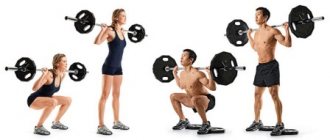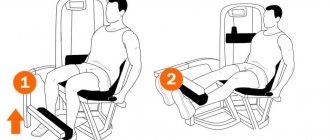Exercises for losing weight on legs and thighs will help you make your legs beautiful and slender. Combining cardio exercises with strength training and static exercises can greatly speed up the process of losing weight.
The first results of diets, when the arrow of the scale finally began to move to the left, literally inspire women. But they are absolutely not happy with the reflection in the mirror. Physiologically, fat deposits begin to disappear from the upper body when you lose weight. And the volumes of the legs and hips remain unchanged for a long time. Many girls understand that coping with the problem without exercises for losing weight at home is unrealistic. But just the desire to make your legs slender is not enough. Achieving real results will take time, persistence and a comprehensive weight loss program.
How long should cardio workouts last?
Cardio exercise allows you to burn calories while increasing your heart muscle endurance and improving your breathing. Find out how long your cardio workout should last based on the goals you want to achieve.
Goal 1 : Return to sport or physical rehabilitation. The goal of training in this case would be to maintain fitness level and limit weight gain.
- Activity: walking, leisurely cycling, exercise bikes.
- Intensity: low.
- Duration: Start with one 30-minute session per day, then increase to 45 minutes (train at least three times a week to see results).
Goal 2 : weight loss. The goal of this workout will be to burn calories.
- Activity: running, exercise bike, cross training.
- Intensity: medium.
- Duration: 40-minute workout two or three times a week. You can slightly increase the duration and frequency of your workouts if you feel that the load is not enough.
Goal 3: Improve athletic performance, as well as increase cardiovascular endurance and increase lung capacity.
- Activity: sprinting, interval training, cycling.
- Intensity: high.
- Duration: 20-30 minute session two or three times a week (mandatory: 48 hour recovery break between sessions).
Remember: as you progress in your sport, your body will require more and more energy to keep your muscles toned.
This way, your muscles will burn more and more calories, and your metabolism will speed up.
Fat-burning training is best done at a heart rate of 170 minus age. If you train at a higher heart rate, then there is a risk that you are not doing a fat-burning workout, but a muscle-burning workout.
The higher the heart rate during training, the shorter the workout. For fat burning, it makes sense to train for a long time, but not hard, that is, with a low heart rate.
For most people, a heart rate of 170 minus age is a comfortable heart rate at which a person can carry on a conversation. For example, with a pulse of 170 minus age, I can consult my clients.
With such a comfortable heart rate, beginners can easily train for 30 minutes.
However, the average person has enough carbohydrates (glycogen) in their body for about two hours of cardio training at a heart rate of 170 minus their age. A person can train for two hours without water or food at a distance.
Doing cardio while eating during exercise doesn't make sense from a fat burning standpoint. On the contrary, to train the body to burn fat, professional runners do long runs on an empty stomach. And very hungry! Before such a fat-burning workout, they do not eat for 18 hours.
A beginner's heart and lungs can handle two hours of cardio, but their musculoskeletal system may not, especially if the person is overweight and has joint problems. This is why 70% of people who start training their hearts with cardio will suffer musculoskeletal injuries.
For two-hour fat-burning workouts, the musculoskeletal system must be prepared first. Therefore, for beginners, I recommend starting with 30 minute workouts and increasing the load by no more than three minutes per week. A cardio workout of less than 30 minutes is too short to be effective in terms of fat burning.
Under the best circumstances, a strong-willed person will be able to increase his cardio training time from 30 minutes to two hours in about 20-30 weeks without risk of injury.
Simple conclusions:
— Minimum time for fat-burning cardio training is 30 minutes; — Maximum time for fat-burning training is 2 hours; — Cardio training time can be increased by no more than 10% per week. — Fat-burning workouts are best done on an empty stomach.
If you need help creating a nutrition plan and cardio workouts to remove extra centimeters, then write to me on , or Instagram.
Lev Goncharov - fitness trainer
View this post on Instagram
Metabolic equivalent load. In medicine, the metabolic equivalent of load—MEN—is often used to assess the body’s energy metabolism. . We are all human and produce energy thanks to oxygen. . At rest, the average person inhales approximately 3.5 ml of oxygen per kilogram of his body per minute. . It is calculated that if a person inhales 3.5 ml of oxygen per kilogram of his body per minute, then his body consumes one kilocalorie per kilogram of body weight per hour. . It is important for athletes to know how much oxygen their body can consume per minute. Ordinary people who just want to look good are often interested in calorie consumption per hour. . Sometimes MEN is taken at rest while sitting rather than standing because people sit more than lie down. In this case, the MEN will increase by 25% and become equal to 1.25 kcal/kg/hour. . Changing body position, such as lying, sitting, standing, walking, running, swimming, changes not only breathing, but also pulse. . Pulse is the easiest way to measure your metabolism. And even small changes in heart rate significantly change MEN. . For example, with a pulse below 65 beats/min, the pulse is 0.5 kcal/kg/hour, and with a pulse of 70 beats/min—1 kcal/kg/hour. . Just ten beats per minute can double your resting metabolism. . When a person goes on a diet, his resting heart rate drops sharply. For example, my resting heart rate during a strict diet could drop from 60 to 50 beats per minute. . This is what “experts” mean when they say “hunger lowers metabolism.” . You used to know that hunger reduces metabolism, and exercise increases it. Now you know that changing your heart rate by 5 beats per minute changes your metabolism by about 0.5 MEN. . If you train with a heart rate monitor, you can easily see how many calories you burned during your workout by reading your heart rate. To do this, you can use the table. And if you lose the table, then just remember that 1 MEN is the load on the body at a pulse of 70 beats per minute. . What if you don't?
A post shared by Lev Goncharov (@levgon1975) on Aug 20, 2021 at 1:58am PDT
Training goal and intensity
First, decide what your goal is, and then tailor your workout to it. For example, if you plan to purposefully develop strength indicators, then in this case the training can easily last up to 2 hours, and this will be considered normal, since its intensity is weak. Why is that? Because the rest between sets will be much longer than when you are training to gain muscle mass or for relief.
If the goal is fat burning, then the workout can also last up to 2 hours, since the first 50-60 minutes will be taken by strength training, and the second 50-60 minutes by cardio training. Or it may be that training for weight loss will take you only 40 - 50 minutes, with all this, you will be much more tired than if you trained for 2 hours. This will happen if your workout is as intense as possible + minimal rest (circuit methods, super sets, giant sets, crossfit elements, etc.).
Effective weight loss exercises at home for men and women
Before starting a workout, you should consult your doctor about the possibility of doing it. The intensity of the load is increased little by little so that the body does not have time to get used to it and the weight loss process does not slow down.
Before classes, first do a warm-up, and after that do stretching exercises.
Important! Cardio training involves constantly monitoring your heart rate during physical activity. This is done using a special device. If a person feels unwell during a workout, it should be canceled immediately.
For beginner girls and young people

A set of exercises for beginners involves light aerobic exercise aimed at improving endurance.
The following types of exercises can be performed at home:
- Push push-ups. This type of exercise is not much different from classic push-ups. The difference is that at the top point you need to push with your hands, throwing your body up. It is better for guys to lean on the floor, for girls - on a bench or sofa.
- Jumping up. Squat with legs wide apart as deeply as possible, and hands folded behind the head. From this position make a sharp jump upward.
- Lying point-blank lunges. You need to sit on your tiptoes and place your arms straight in front of you. During the jump, the legs are thrown back, resting on the palms. Then, using a jump, they return to the starting position.
For beginners, your own body weight will be enough for regular training. Weights are not used in the initial stages.
An approximate complex designed for beginners:
- standard squats – 20 times;
- push-ups – 10 times;
- lying lunges - 10 times;
- jumping up – 15 times;
- jumping in place – 30 times.
You need to work according to the presented system in cycles, that is, in several approaches. To normalize your heartbeat, after exercise you need to stretch your muscles. The complex starts with 5 minutes and gradually increases the duration of the load to 40-50 minutes.
Male complex

Cardio training at home is also suitable for representatives of the stronger sex who want to adjust their body weight.
To achieve the desired result, it will be enough for them to regularly perform the following types of exercises:
- Running up and down stairs. The duration of the load is 7-10 minutes with a rest break of 60 seconds. Jogging can be replaced by exercise on an exercise bike. In this case, the duration of the exercise is reduced to 5 minutes.
- Quick push-ups (15-20 times) . After completing the complex, rest for 30 seconds and do another 2-3 approaches. If your level of physical fitness allows, then the exercise can be complicated: do push-ups with cotton.
- Wide squats . The legs are placed wider than the shoulders, the back is straightened. Do deep squats without lifting your heels off the floor (up to 25 times). You can complicate the exercises by jumping up or clasping your hands behind your head.
- Plank. During the complex, a man should rest only on his forearms and socks brought together. It is important that during exercise the spine is parallel to the floor. Hold the plank for a minute and then take a break of 30 seconds. For men who constantly practice cardio training, you can complicate the complex: alternately lift your right and left legs in the “Plank” position or lift your forearms off the floor.
- Burpees. It is considered one of the most difficult exercises in the men's complex. It is performed from a position on all fours so that the knees are in contact with the chest. The legs are sharply pulled back so that the body assumes a lying position. After this, they return to the starting position and jump up with their arms outstretched.

A set of exercises for cardio training for men:
- burpees – 20 repetitions;
- wide squats – 30;
- push-ups from the floor – 25 times;
- bar;
- running with high knees – 2 minutes.
Exercises are done 2-3 times with stops until breathing is completely restored.
If training takes place at home, then you need to select exercises that suit your abilities. In this case, doctors and trainers will not be able to control the level of physical activity.
Features of women's programs

The difference between women's cardio training and men's is that most exercises are aimed at working the lower body. The most problematic areas for the fairer sex are the hips and buttocks, so the emphasis is primarily on them, as well as the stomach and sides.
This allows women to reduce their body proportions without gaining muscle mass.
Suitable complexes for girls:
- intense jumping, including jumping rope;
- exercise "bicycle";
- running in place;
- lunges;
- various swings of the lower limbs.
Types of cardio exercises for weight loss at home for women:
- "Bouncer." Feet are placed together, arms are lowered. When jumping, the lower limbs are shoulder-width apart, and the upper limbs are raised upward. They return to their original position without delay. The number of repetitions is about 10-15 times. This type of exercise requires a lot of energy and is ideal for burning excess calories. Training for girls will tighten the inner and outer thighs.
- "Skater". The body is tilted forward, legs are shoulder-width apart. As you exhale, lunge with your left leg and touch your foot with your opposite hand. The upper limb of the same name should be retracted. Similar movements are repeated for the other side.
- Jumping "Star". Sit in a semi-squat position, rest your hands on the floor, bend your legs at the knees. As you exhale, make a high jump up, simultaneously spreading your lower and upper limbs to the sides. When lowering, the arms and legs are brought together again.
Approximate cardio complex for women:
- running in place with your shins overlapping – 20 times;
- jumping rope – 2 minutes;
- speed skater exercise – 25;
- running with high knees in front of you – 20;
- jumping “Star” – 10.
You may also be interested in: Cardio Nutrition for Weight Loss
Fat burning workouts at home for women
Number of workouts per week
This factor also affects the duration of training in the gym, since there is a big difference if you train 5 times a week for 40 minutes and 5 times a week for 2 hours. In the first case, you will be able to progress easily, since you will have time to fully recover, but in the second case, such pronounced progress may not be observed, since there is very strong stress and a heavy load. To grow, there shouldn't be too much stress (will lead to overtraining) and too little stress (not a sufficient impetus for growth). You need the optimal amount (golden mean).
It turns out that the more workouts per week, the shorter each workout should be. If you can only train once a week, then you can actually hang out in the gym for 2.5 – 3 hours (if you can survive). Yes, the level of destructive hormones will be high, but in the future you will have 6 days of rest to fully recover. If you train 3 times a week, then the training can be 60 - 90 minutes (again, you need to take into account your experience and genetic potential). In general, I think you got the main idea.
Example of a home cardio workout
If for some reason you cannot go to the gym, cardio training can be done at home. Stock up on a heart rate monitor and go ahead – run, walk, jump rope. You can download a couple of files with aerobics or dance recordings and practice at any convenient time. Push-ups and frog jumps raise your heart rate well.
You can finish your workout at home by doing a plank - this will involve all muscle groups.
Forgot or didn’t know what a plank is? Lie on the floor, rest your toes and forearms on the floor. The body is straight, without bending, the elbows are located strictly under the shoulders. Try standing without preparation for at least 20 seconds after a dynamic load.
Mass training: optimal duration
The average duration of weight training is 1-1.5 hours. This value is the most acceptable and gives the best return. Naturally, such rules need to be adjusted based on the level of the athlete. Thus, training a professional bodybuilder takes approximately 40-60 minutes, this value is associated with the use of specialized programs for pumping a specific muscle or muscle group. For beginners, such training is hardly the best option, since at the initial stage it is necessary to provide all muscle groups with the necessary basic foundation. In addition, novice athletes should not strictly limit themselves in rest between approaches and exercises.
It should be borne in mind that it is not recommended to delay training for too long, since this leads to increased production of cortisol, which in turn is aimed at destroying muscle tissue. And prolonged training creates conditions for overtraining.
How to properly organize your training process?
It all depends on the ultimate goal - losing weight or gaining weight - but in both cases the following tips for organizing training will be relevant:
- Do not visit the hall during rush hour. At this time, queues line up at the exercise machines, which increases the rest time between approaches;
- To burn fat, you need to combine strength and aerobic training, and to gain muscle mass, on the contrary, do it on different days;
- Do not be distracted from the exercises: this negatively affects the execution technique and increases time costs;
- Change your training program periodically. A signal to change the program is a deterioration or suspension of progress;
- Use supersets. They increase the intensity level of the activity;
- Take 1.5 liters of still water with you. This will reduce the time spent on trips to the cooler between approaches.
Progression of loads
There are different types of cardio training, each of which includes a certain procession of loads.

Types of training:
- a long activity that does not involve rest breaks: should last at least an hour, it may include running;
- interval: alternates with 5-minute intervals, during which there is a change of activity;
- fartlek: a workout that has similar functions to interval training, but adds recovery periods;
- aerobic: here you alternate exercises in which you work with and without a load (for example, squats and elliptical);
- cross: includes a dynamic (about 15 minutes) change in the type of exercise, in addition, alternating training days is allowed here (Monday - only running, Wednesday - aerobics, etc.).











